From Blockchain to Distributed Ledger Technology (DLT) If you follow the news, you might have realized that the term DLT is currently more and more used to describe what we usually describe with “the Blockchain”. Even though the definitions are more or less subjective, a good comparison between these technologies is here. In really easy terms, the DLT is the Blockchain without the “chain of blocks”, which also means without the security and immutability of the blockchain. However, as with private chains vs. public chains, this might exactly be what you need for your use case. So, keep in mind that Bitcoins are not the Blockchain and that the Blockchain is more than DLR and all of these technologies fit perfectly to their use cases, which are certainly not the same. It helps to know about the definitions to get more information about the complete topic, since DLT is not as spammed (aka SEOed) as Blockchain, a Google searchs gets you more valuable results like the BaFin evaluation and the really well made UK Government Science report. Even more about the Blockchain Fed up with all the small bits and pieces about Blockchain technology on all those news sites? Then read a book, we recommend “The Blockchain” from leanpub and hope that it will be completed soon. More into videos? Then watch primavera in her talk about Skynet or Freenet or her more current talks.
Month: May 2016
KW 20.16 – Weekly Blockchainers Recap
The DAO .. reached $ 157 mio. founding. The ethereum based crowd funding decentralized business organization collects a lot of money to support ether based business. It looks like the first blockchain venture capital organization to boost the ethereum cosmos. Strong disruption alert ! Deloits Rubix blockchain Beta launched Deloits starts their own blockchain program Rubix. It focuses on Enterprise Blockchain distributed apps (Dapps). Rubix should become an industry-leading blockchain infrastructure provider. It’s still enough space for solution witch helps to transform the old economy to the distributed economy. The DAO – Part 2 What is it? Is it a bubble or even a ponzi scheme (as everything unknown is a ponzi scheme obviously)? Is it a great investment possibility? Is it Freenet or Skynet? Or is it just the betting on Vitalik Buterin and his gang that they will put forward something extremely useful which is worth all this founding? Make up your own mind, but beware that this is no recommendation to buy DAO-Tokens. Don’t get it wrong: we actually believe in the concept of the DAO and that it will establish an intelligent, interactive investment possibility with huge gains, but looking at the current DAO: ~$200 mio. for slock.it and another, not even published proposal? Smells like tulips.
KW 19.16 – Weekly Blockchainers Recap
NATO Blockchain Innovation Contest The NATO is a decentralized organisation with a lot of partners, processes and logistical challenges. It’s a clever idea to use a decentralized ledger for a couple of problems in this kind of organizations with strong security needs. They start with an inovation contest to find good use cases. Congratulation for this innovative approach. Cryptovalley Zug accept Bitcoins The city Zug in Swiss starts to accept Bitcoins on first of July for the payment of public services. It looks like a good marketing strategy for the local economic promotion. Zug is know as the hometown of Ethereum and other crypto companies. (Sorry, the official city website is just in German.) Youtube channels If you don’t find anything on TV look at : A presentation from BlackRock Engineering about Ethereum or the channels from Andreas M. Antonopoulos and BitBond
Ethereum Development Tools – an Evaluation Matrix
Developing for the Ethereum World Computer – Revisited
When comparing development methods for and in the Ethereum space, it becomes obvious how brilliant the people involved actually are: as a developer, you have several choices of great development tools and environments, even though the development process for Dapps is quite difficult: it involves different “layers” (frontend with HTML/CSS/JavaScript and backend with the Ethereum blockchain), different languages (JavaScript for frontend dev, Solidity for backend dev), different contexts (public/private/proprietary blockchains).
Taking these different contexts into account, evaluating the different development environments is only possible by identifying the different aspects and value them according to the own preferred usage.
Aspects of Dapp Development
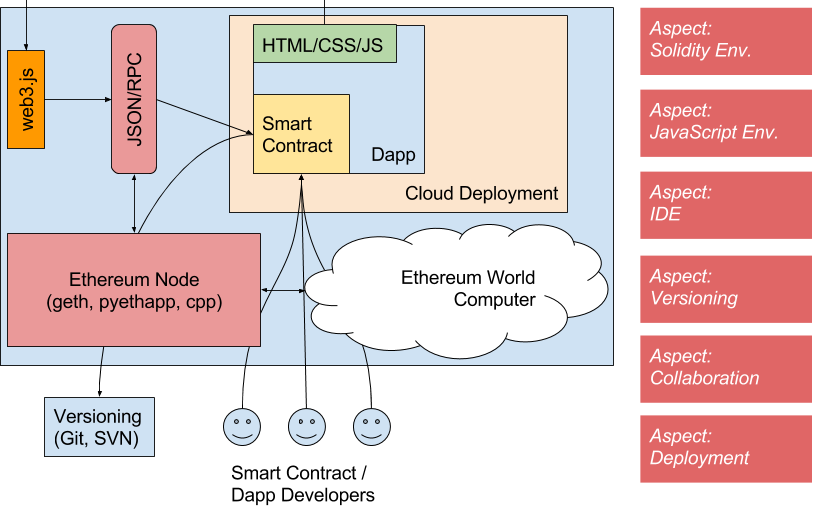
- Solidity Development / Solidity Environment
User can edit Solidity content in a text editor, there should be at least syntax highlighting. - JavaScript/Web Environment
User can edit JavaScript, HTML and CSS in a text editor and gets different levels of support like syntax highlighting, code completion, etc. - IDE
User can not only edit code (Solidity and JavaScript), but can also compile, check into a versioning system, debug and deploy to some operating environment. - Versioning
Versioning is supported, eg. by enabling the user to check edited content into a versioning system, show diffs, apply patches, etc. - Collaboration
Modification of code by multiple users is supported, at minimum support of different versions of the code is possible to avoid conflicts. - Deployment
Working code can be deployed to some environment which enables the user and other users to use the working program (a sandbox or real blockchain and a web application server for JavaScript like node.js and static content like HTML and CSS files)
A first Categorization and a Teaser
We will summarize in short the different aspects which are supported in these development environment: Solidity Browser / Ethereum Wallet, Truffle and Ethereum Studio.
This is also a teaser for the upcoming blog posts, which will explain the environments in detail.
Solidity Browser / Ethereum Wallet
In terms of architectural styles, both environments represent minimalism. They are slim and handy, easy to use and fast to learn, but lack some functionality if real development “in the large” is necessary.
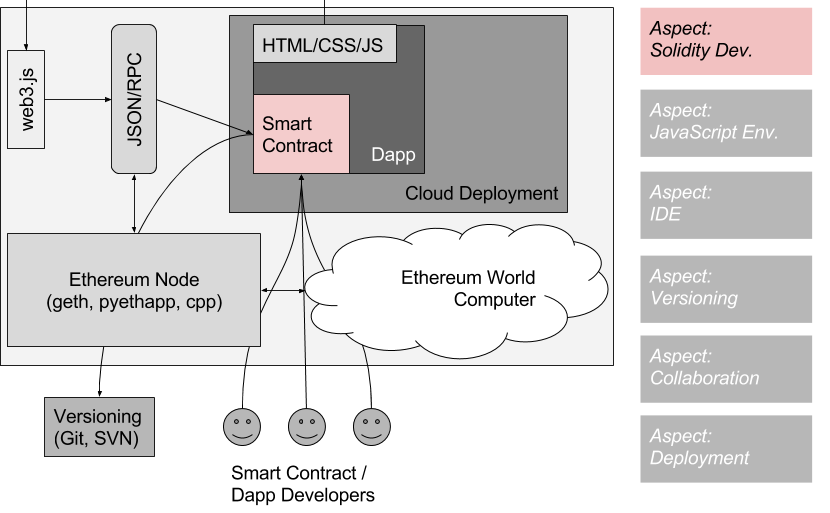
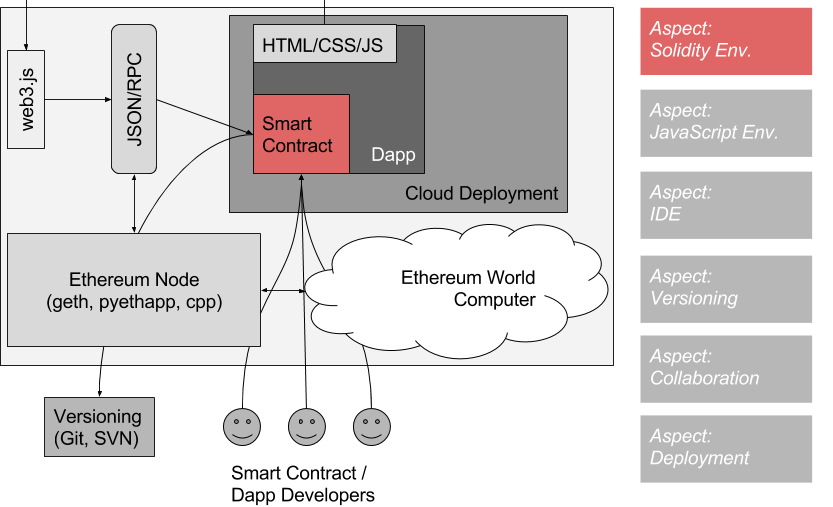
Truffle (also: Embark, Dapple)
Truffle satisfies all aspects which a usual client application can offer, therefore you can think of Gothik, it is mighty, almost lavish, and well structured. If you come from web development in JavaScript with node.js, who should look no further, this environment is for you (at least if you don’t need support for online development, versioning and multi user directly in your environment, but use external tools like Git and testrpc for these aspects).
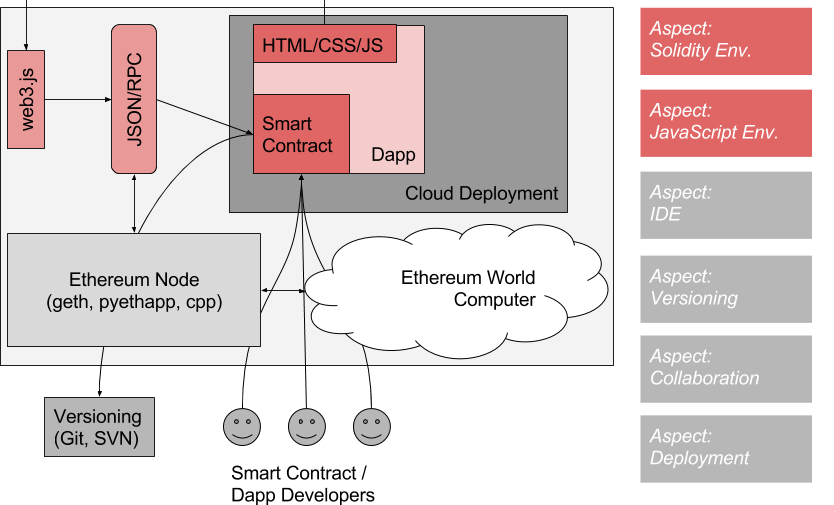
Ethereum Studio, the all-in-one-solution
The Ethereum Studio, in our opinion, resembles Deconstructivism. Why’s that? Because here all aforementioned aspects of software development are taken apart and are reconstructed to fit perfectly to Dapp development. This is an all-in-one-solution which we can really recommend, with two limitation: you have to agree to a uncertain pricing model (it just doesn’t exist right now, you can still test the product) and a “closed” environment, which works seemless and smooth, but expects you to let in to this tool and the development process.
But no other tool lets you test your code this easy with manual and even unit testing built into the environment.
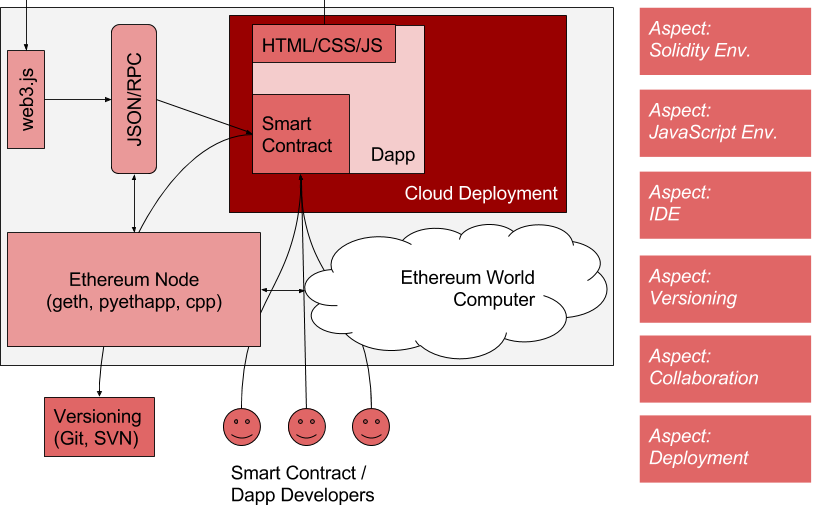
Stay tuned for the detailed explanations of these great development tools.
KW 18.16 – Weekly Blockchainers Recap
Amazon’s Blockchain as a Service Amazon announced Blockchain as a Service. You can use a blockchain from Microsoft Azur or from the IBM Cloud, now Amazon also want to offer a service. I like working with AWS, so I hope the blockchain service will fit perfectly to the existing datacenter services. Akasha Project The Akasha Project has a high disruption potential. It is a decentralized social multimedia network, based on Ethereum. Akasha could be a game changer. Satoshi Nakamoto This week you found many articles about Craig Steven Wright. “Is he Satoshi, or not”, the trough is … the articles are interesting, but you know nothing, Jon Snow.
